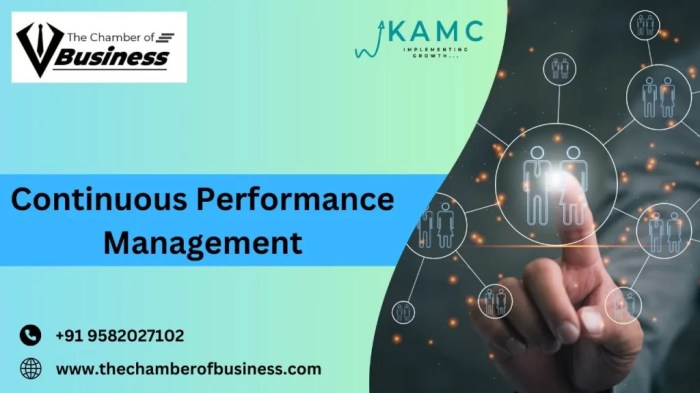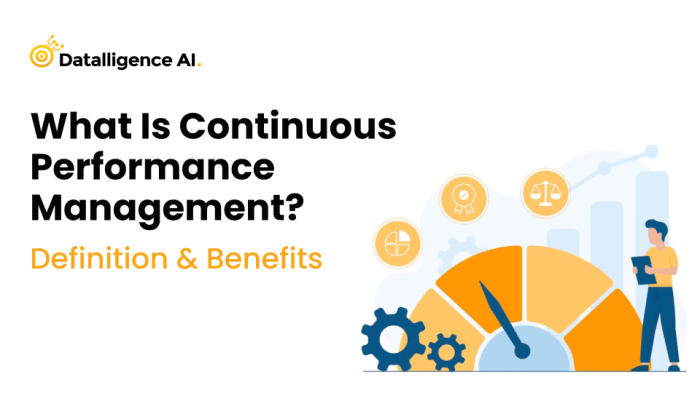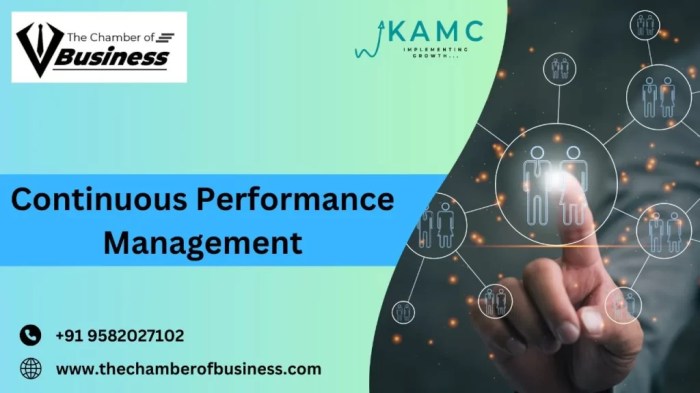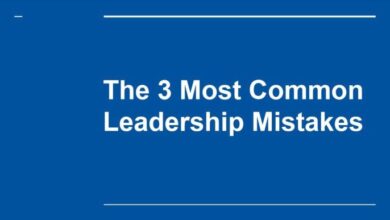
Benefits continuous performance management is a powerful approach to elevate employee engagement and organizational success. It’s a system that moves beyond traditional annual reviews, embracing a more dynamic and proactive approach to performance. This framework fosters continuous feedback, enabling targeted development and improvement, ultimately boosting productivity and driving overall organizational growth.
This in-depth exploration dives into the core benefits of implementing a continuous performance management system. We’ll uncover how it impacts employee development, leadership effectiveness, and overall organizational performance. We’ll also examine the key challenges and considerations in adopting this modern approach.
Defining Continuous Performance Management (CPM)
Continuous Performance Management (CPM) is a dynamic approach to performance improvement that moves away from the traditional annual review cycle. Instead, it fosters ongoing feedback, coaching, and development conversations between managers and employees. This approach aims to improve employee engagement, productivity, and overall organizational success by making performance improvement an ongoing process, not a one-time event.CPM recognizes that performance is a fluid and evolving aspect of work.
It acknowledges that needs and priorities change, and that feedback and support should be readily available, not just once a year. This shift in perspective is crucial to creating a positive and productive work environment.
Key Characteristics of a CPM System
CPM systems are built on several key characteristics. These include regular check-ins, personalized development plans, and frequent feedback loops. A successful CPM system provides a framework for consistent dialogue between managers and employees, enabling continuous improvement and a more agile response to evolving business needs.
- Regular Check-ins: Regular one-on-one meetings, ideally weekly or bi-weekly, are crucial for ongoing performance discussions. These meetings should be structured to cover progress, identify roadblocks, and provide opportunities for coaching and support.
- Personalized Development Plans: Individualized development plans, based on performance goals and identified areas for improvement, allow for targeted support and skill enhancement. These plans should be dynamic, adapting to changing circumstances and employee aspirations.
- Frequent Feedback Loops: Continuous feedback is a cornerstone of CPM. This includes both formal and informal feedback, from managers, peers, and even clients, providing a holistic view of performance.
Components of a CPM System
A comprehensive CPM system encompasses various components that work together to create a supportive and productive environment.
- Performance Goals: Clear, specific, measurable, achievable, relevant, and time-bound (SMART) goals are essential for both individual and team performance. These goals provide a framework for tracking progress and understanding performance expectations.
- Feedback Mechanisms: A variety of feedback mechanisms, including regular check-ins, formal reviews, and peer feedback, provide a rich source of information about performance and development needs. This feedback should be constructive and actionable, focusing on both strengths and areas needing improvement.
- Development Opportunities: Access to training, mentorship, and other development opportunities is critical to fostering employee growth and improving performance. This aspect recognizes that individuals need ongoing opportunities to develop skills and knowledge.
CPM vs. Traditional Performance Reviews
Traditional performance reviews, often annual events, are fundamentally different from CPM. They typically focus on past performance, leading to a retrospective assessment rather than a forward-looking approach. CPM, on the other hand, is focused on continuous improvement and development.
| Feature | Continuous Performance Management (CPM) | Traditional Performance Reviews |
|---|---|---|
| Frequency | Regular, ongoing | Annually |
| Focus | Continuous improvement, development, and feedback | Retrospective assessment of past performance |
| Approach | Proactive, developmental | Reactive, summative |
| Feedback | Ongoing, actionable | Occasional, less actionable |
| Impact | Improved employee engagement, higher performance, greater agility | Potential for improved performance, but often less impactful due to limited feedback frequency |
| Flexibility | Highly flexible, adapting to changing needs | Less flexible, tied to annual cycles |
Benefits of Implementing CPM
Continuous Performance Management (CPM) is no longer a futuristic concept; it’s a powerful tool transforming workplaces worldwide. By shifting from annual reviews to ongoing feedback and development, CPM fosters a more dynamic and engaged workforce, ultimately boosting overall organizational performance. It’s about creating a culture where growth and improvement are not just goals, but a daily practice.CPM is a significant investment in human capital, not just a change in process.
It’s a shift from a reactive approach to performance evaluation to a proactive strategy focused on continuous development and improvement. This approach leads to increased employee satisfaction, stronger leadership, and improved organizational outcomes.
Continuous performance management offers clear benefits, like improved employee engagement and streamlined feedback loops. Imagine the potential for a future where such feedback systems are augmented by cutting-edge tech, like Microsoft’s explorations into holodeck-ish tech in patent applications here. This could revolutionize how we approach performance evaluations, fostering a more dynamic and responsive work environment. Ultimately, the benefits of continuous performance management could become even more impactful with such innovative advancements.
Impact on Employee Engagement and Motivation
Implementing CPM systems demonstrably improves employee engagement and motivation. Regular feedback loops, combined with clear performance expectations and development opportunities, foster a sense of ownership and purpose. Employees feel valued when their contributions are recognized and their growth is actively supported. This creates a positive work environment where employees are more likely to be invested in their roles and the overall success of the organization.
Fostering a Culture of Continuous Improvement and Development
CPM encourages a culture of continuous improvement and development by making feedback and development a regular part of the workday. This proactive approach shifts the focus from addressing past performance to proactively identifying areas for improvement and skill enhancement. The consistent dialogue between managers and employees ensures that skills are sharpened, knowledge is updated, and employees feel empowered to reach their full potential.
This iterative approach to growth translates into a more adaptable and innovative workforce.
Increased Productivity and Performance
Clear performance expectations, coupled with regular feedback, contribute significantly to increased productivity and performance. Employees understand what’s expected of them and receive the support they need to achieve those goals. This transparency and support reduce ambiguity and frustration, leading to more efficient workflows and higher quality outputs.
Measurable Outcomes of CPM Initiatives
The effectiveness of CPM can be measured through various metrics, demonstrating a clear return on investment. These metrics extend beyond just financial gains and encompass employee well-being and organizational growth.
Continuous performance management offers tons of benefits, like boosting employee engagement and identifying skill gaps. This directly impacts overall productivity. It’s interesting to see how Windows 8 or Android could potentially challenge the iPad’s dominance in the tablet market, particularly in areas like versatility and customizability how Windows 8 or Android could beat Apple’s iPad. Ultimately, a well-implemented continuous performance management system can significantly improve organizational performance.
| Metric | Description | Measurable Outcome |
|---|---|---|
| Employee Satisfaction Surveys | Measure employee satisfaction levels regarding feedback processes, development opportunities, and overall work environment. | Improved employee engagement, reduced employee turnover. |
| Performance Metrics (e.g., sales figures, project completion rates) | Track key performance indicators (KPIs) to evaluate the impact of CPM on business outcomes. | Increased productivity, improved quality of work, higher sales. |
| Employee Feedback Data | Analyze employee feedback on performance reviews and development plans to identify areas for improvement. | Enhanced employee understanding of performance expectations, reduced ambiguity, higher job satisfaction. |
| Training and Development Participation Rates | Monitor the number of employees participating in training and development programs. | Improved skill sets, higher levels of competency, enhanced employee value proposition. |
CPM and Employee Development
Continuous Performance Management (CPM) isn’t just about evaluating past performance; it’s a powerful tool for fostering employee growth and development. By creating a culture of ongoing feedback and constructive dialogue, CPM paves the way for targeted training, personalized development plans, and ultimately, a more skilled and engaged workforce. It’s about moving beyond the annual review to a continuous cycle of improvement.CPM facilitates a dynamic approach to employee development, recognizing that learning and growth are ongoing processes.
This shift from periodic assessments to a consistent feedback loop empowers employees to identify their strengths and areas for improvement, leading to a more proactive and effective development strategy.
How CPM Supports Employee Growth and Skill Development
CPM supports employee growth by providing a constant stream of feedback. This feedback is crucial for employees to understand their performance, identify areas needing improvement, and develop strategies for achieving their professional goals. Regular, constructive feedback allows for timely interventions and prevents issues from escalating, ensuring that employees receive the necessary support to succeed. The emphasis on ongoing feedback promotes a culture of continuous learning and improvement.
Continuous performance management offers clear benefits, like boosting employee engagement and identifying skill gaps. However, with the exciting new advancements in electric vehicles, like those showcased in whats new in the electric car boutiques , it’s crucial to keep pace with evolving trends. Ultimately, a strong performance management system allows companies to adapt and thrive, no matter the industry changes.
Feedback Loops for Targeted Training and Coaching
Feedback loops within CPM are instrumental in identifying specific training needs. By analyzing performance data and employee feedback, organizations can pinpoint areas where employees need additional support or skills. This data-driven approach allows for targeted training programs that address specific skill gaps and enhance overall employee capabilities. Coaching sessions, tailored to individual development needs, become more effective and relevant, further fostering professional growth.
Identifying Skill Gaps and Development Opportunities
CPM’s continuous monitoring of employee performance allows for the proactive identification of skill gaps. By tracking key performance indicators (KPIs) and gathering feedback, organizations can anticipate future needs and provide training opportunities in advance. This foresight enables the development of a more robust and adaptable workforce, ensuring employees possess the necessary skills to meet evolving organizational demands. Regular performance reviews, along with feedback from managers and peers, provide a comprehensive picture of an employee’s strengths and weaknesses.
Examples of Personalized Development Plans
A company using CPM might identify a software engineer who consistently struggles with problem-solving in complex projects. CPM data reveals this pattern, leading to a personalized development plan that includes targeted training sessions on software design principles, problem-solving methodologies, and collaborative project management. This tailored approach focuses on the specific needs of the individual, maximizing the impact of the training.
Another example involves a sales representative who excels in closing deals but struggles with client relationship management. A personalized plan might incorporate coaching sessions on client relationship building techniques and effective communication strategies.
Comparison of Employee Development Programs
| Type of Program | Description | CPM Facilitation |
|---|---|---|
| Internal Training Programs | Company-led courses or workshops | CPM identifies skill gaps and targets training to specific roles or individuals. |
| Mentorship Programs | Pairing experienced employees with junior colleagues | CPM facilitates matching mentors with mentees based on specific skill development needs. |
| External Certifications | Acquiring industry-recognized certifications | CPM helps employees identify certifications that align with their career goals and the company’s strategic objectives. |
| On-the-Job Training | Learning by doing | CPM provides feedback on on-the-job performance, guiding employees toward optimal learning experiences. |
CPM and Leadership Development
Continuous Performance Management (CPM) isn’t just about evaluating individual employee performance; it also offers valuable insights into leadership effectiveness. By tracking and analyzing leadership behaviors, CPM provides a powerful tool for identifying areas needing improvement and fostering leadership growth. This approach helps organizations cultivate a strong leadership pipeline, enhancing overall team performance and organizational success.CPM allows leaders to understand how their actions impact team dynamics and individual employee experiences.
This feedback loop, when properly utilized, translates into actionable strategies for refining leadership styles and strengthening leadership skills. By recognizing patterns and trends, organizations can proactively address potential issues and create a more supportive and productive work environment for all.
Leadership Effectiveness Insights from CPM
CPM provides a comprehensive view of leadership effectiveness by collecting data on various aspects of leadership performance. This data includes feedback from direct reports, self-assessments from leaders, and observations from supervisors. By combining these diverse perspectives, organizations can gain a holistic understanding of a leader’s strengths and areas for improvement. This multifaceted approach allows for a more accurate and nuanced evaluation than traditional methods, often limited to annual reviews.
Identifying Areas for Leadership Improvement
CPM facilitates the identification of specific areas needing attention within a leader’s approach. By analyzing trends in employee feedback, performance metrics, and engagement levels, organizations can pinpoint areas where leaders might be falling short. This could include communication styles, delegation strategies, or conflict resolution techniques. This targeted approach ensures that leadership development initiatives address specific needs, maximizing their impact.
For instance, if a consistent theme emerges from employee feedback regarding a leader’s communication style, CPM data can highlight this pattern and direct training toward improving clarity and empathy in communication.
Building Leadership Skills Through CPM
CPM plays a crucial role in building and enhancing leadership skills. Regular feedback and performance data, coupled with targeted training programs, enable leaders to develop their strengths and refine their weaknesses. This iterative process promotes a culture of continuous improvement, equipping leaders with the skills necessary to navigate challenges and drive success. Leadership development, when aligned with specific CPM data, leads to more effective leadership across the organization.
CPM and Leadership Training Programs
CPM data significantly informs the design and implementation of leadership training programs. By identifying common areas for improvement, organizations can tailor training content to address specific leadership challenges. For example, if CPM reveals a need for better delegation skills, the training program could include practical exercises and case studies focused on effective delegation techniques. This targeted approach ensures that training programs are relevant and effective, directly addressing the identified needs of the leadership team.
Leadership Styles and CPM Tailoring
| Leadership Style | CPM Focus Areas | Example CPM Metrics |
|---|---|---|
| Transformational | Inspiring vision, fostering innovation, promoting growth | Employee engagement scores, project completion rates, initiative taking |
| Transactional | Clear expectations, consistent performance standards, reward-and-recognition systems | Employee satisfaction with performance reviews, adherence to deadlines, productivity levels |
| Servant | Empowering team members, fostering collaboration, listening actively | Employee satisfaction with support and mentorship, team collaboration scores, feedback on mentorship quality |
| Situational | Adapting leadership style to specific situations, recognizing individual needs | Employee feedback on the perceived appropriateness of the leadership style, adjustments to team goals based on individual needs |
This table illustrates how CPM can be tailored to address the unique needs of different leadership styles. By focusing on specific metrics relevant to each style, organizations can gain a deeper understanding of how leaders operate and identify areas for growth. This data-driven approach fosters a culture of continuous improvement and leadership development.
CPM and Performance Improvement

Continuous Performance Management (CPM) isn’t just about tracking progress; it’s a powerful tool for proactively identifying and addressing performance issues. By fostering open communication and regular feedback, CPM empowers both managers and employees to work together toward improvement, leading to a more engaged and productive workforce. This approach goes beyond the annual review, fostering a culture of ongoing development and success.CPM excels at pinpointing performance gaps early on, enabling organizations to implement targeted interventions before problems escalate.
This proactive approach saves time and resources, and ultimately leads to better overall performance.
Identifying Performance Issues Timely
CPM systems facilitate regular check-ins and performance reviews, allowing managers to monitor employee progress and identify potential issues early. This proactive approach contrasts with traditional annual performance reviews, which often uncover problems only after they’ve become significant. By tracking key performance indicators (KPIs) and gathering feedback throughout the year, CPM systems can highlight areas where employees may be struggling or where processes need adjustment.
This early detection empowers organizations to implement solutions quickly, preventing issues from derailing projects or impacting team performance.
Proactive Methods for Addressing Performance Concerns
A robust CPM system includes methods for addressing performance concerns proactively. This can involve regular one-on-one meetings, coaching sessions, and performance improvement plans (PIPs). For instance, if an employee consistently misses deadlines, a manager can schedule a meeting to discuss the root cause and develop strategies for improvement. This personalized approach addresses the specific needs of the employee and ensures the feedback is constructive and actionable.
The goal isn’t just to point out shortcomings, but to empower employees with the tools and support they need to succeed.
Facilitating Continuous Performance Improvement Conversations
CPM fosters a culture of continuous feedback and improvement. Regular check-ins, 360-degree feedback, and ongoing performance discussions encourage open communication and create a safe space for employees to express their concerns and seek guidance. This ongoing dialogue helps managers identify trends and areas where employees might need additional support or training. These conversations should be focused on solutions and development, creating a collaborative environment where everyone feels empowered to improve.
Examples of CPM Supporting Employee Improvement
A sales representative consistently falling short of targets can benefit from a CPM system that tracks their sales performance and provides regular feedback. By identifying patterns in their sales pipeline, the manager can pinpoint areas where the employee might need additional training or support. For example, the system might reveal a lack of proficiency in a specific sales technique.
The employee can then participate in a focused training program to strengthen these skills. This targeted approach, supported by ongoing feedback and coaching, will help the employee overcome their performance challenges.
Performance Improvement Strategies via CPM
| Strategy | Description | Example |
|---|---|---|
| Coaching and Mentoring | Providing guidance and support to improve specific skills or knowledge. | A manager coaches a junior employee on effective communication strategies. |
| Skill Development Programs | Offering training or workshops to enhance employees’ capabilities. | Providing a course on sales techniques for a struggling sales team. |
| Performance Improvement Plans (PIPs) | A formal plan outlining expectations, support, and consequences for underperformance. | Developing a structured plan for an employee who consistently misses deadlines, including specific action steps and a timeline. |
| Feedback and Recognition | Providing regular feedback and acknowledging accomplishments to reinforce desired behaviors. | Giving regular praise and feedback to an employee exceeding targets. |
| Process Improvement | Analyzing and adjusting workflows to enhance efficiency and effectiveness. | Streamlining a process to reduce bottlenecks and improve productivity for a team. |
CPM and Organizational Performance

Continuous Performance Management (CPM) isn’t just about individual employee growth; it’s a powerful tool for driving organizational success. By aligning individual efforts with broader company objectives, CPM creates a powerful synergy that fuels progress and enhances overall performance. It’s a dynamic approach that fosters a culture of continuous improvement, making the organization more adaptable and responsive to changing market conditions.CPM facilitates a clear understanding of how individual contributions impact the bigger picture.
This alignment isn’t just theoretical; it’s a practical mechanism for achieving organizational goals and objectives more effectively. It promotes a culture of collaboration and shared responsibility, essential for navigating complex challenges and capitalizing on opportunities.
Alignment of Individual and Organizational Performance
CPM creates a direct link between individual performance goals and organizational objectives. This alignment ensures that everyone is working towards the same strategic vision. Clear communication of organizational goals, cascading them down to individual targets, is crucial. By linking individual contributions to broader organizational strategies, employees understand their role in the overall success of the company. This fosters a sense of ownership and commitment, leading to improved performance at all levels.
Enhancing Team Collaboration and Communication
CPM fosters a culture of open communication and collaboration within teams. Regular feedback sessions, facilitated by the CPM process, enable teams to identify strengths, weaknesses, and areas for improvement. This transparency promotes a collaborative environment where team members can support each other, learn from each other’s experiences, and achieve collective success. Shared goals and regular check-ins make teams more effective and efficient.
Measuring Overall Organizational Performance
CPM provides several avenues for measuring overall organizational performance. Key Performance Indicators (KPIs) like customer satisfaction scores, revenue growth, employee retention rates, and project completion rates can be directly tracked and analyzed in the context of CPM. Regular reviews of these KPIs, alongside feedback from employees and customers, provide valuable insights into the effectiveness of the CPM system itself.
The data collected can then be used to make adjustments to the strategy and processes, ensuring continued progress toward organizational goals. For example, if employee retention is low, CPM data can help identify areas in need of improvement, like compensation, training, or management styles.
Examples of CPM for Organizational Performance Measurement
One example of using CPM to measure organizational performance is tracking customer satisfaction scores. A company could implement regular customer surveys and use CPM feedback loops to identify areas where customer service needs improvement. If the scores decline, CPM discussions can help identify specific factors and take corrective actions, like providing additional training for customer service representatives or adjusting service procedures.
Another example is analyzing project completion rates. CPM can highlight potential bottlenecks in project timelines, enabling managers to provide support and resources to teams facing challenges. This proactive approach prevents delays and ensures project success.
Impact of CPM on Key Performance Indicators (KPIs), Benefits continuous performance management
| KPI | Potential Impact of CPM |
|---|---|
| Customer Satisfaction | Improved scores through identified areas for service improvement. |
| Revenue Growth | Increased revenue through effective resource allocation and better sales strategies. |
| Employee Retention | Higher retention rates through better recognition, development opportunities, and a more positive work environment. |
| Project Completion Rate | Improved completion rates by addressing bottlenecks and providing necessary support. |
| Productivity | Increased productivity through improved efficiency and resource utilization. |
Challenges and Considerations in Implementing CPM
Continuous Performance Management (CPM) offers significant advantages for organizations, but its successful implementation requires careful consideration of potential hurdles. A poorly executed CPM system can lead to frustration, resistance, and ultimately, failure to achieve desired outcomes. This section delves into the key challenges and strategies to navigate them effectively.
Potential Challenges in Implementing a CPM System
Implementing a new performance management system inevitably presents challenges. Resistance to change, lack of clear communication, and inadequate training can significantly hinder the effectiveness of CPM. Data security and privacy concerns are also critical considerations. Furthermore, ensuring alignment between the CPM system and overall organizational goals is essential for maximizing its impact. Integrating CPM with existing HR systems and processes can also be complex.
Strategies to Overcome Resistance to Change in Adopting CPM
Resistance to change is a common hurdle in any organizational transformation. Open communication, emphasizing the benefits of CPM, and actively soliciting feedback from employees can help address concerns and build support. Clearly articulating how CPM will improve individual and team performance, and providing ample opportunity for questions and discussion, are crucial steps. Addressing perceived anxieties about the system’s impact on job security, performance reviews, and promotions through transparent communication is vital.
Importance of Proper Training and Communication to Support CPM
Comprehensive training is essential for ensuring employees understand how to use the CPM system effectively. This includes clear guidelines on goal setting, feedback mechanisms, and performance improvement plans. Regular communication channels, such as newsletters, Q&A sessions, and dedicated training materials, should be established to keep employees informed and address any questions or concerns. Effective training should also cover the benefits of CPM for individual development and organizational growth.
This training should be ongoing, not just a one-time event.
Importance of Data Security and Privacy in CPM Implementation
Data security and privacy are paramount in any performance management system. Robust security measures, including access controls and encryption, should be implemented to protect sensitive employee information. Compliance with relevant data privacy regulations, such as GDPR, is critical. Organizations must establish clear policies outlining how employee data will be collected, stored, and used within the CPM system.
Data security should be a top priority throughout the implementation and ongoing maintenance of the CPM system.
Common Pitfalls and How to Avoid Them in a CPM Implementation
Implementing CPM successfully requires careful planning and execution. Failing to tailor the system to the specific needs of the organization is a common pitfall. Overcomplicating the system, leading to confusion and resistance, is another. Insufficient resources, including time and personnel, can also hinder success. Lack of senior leadership support and involvement can undermine the entire initiative.
To avoid these pitfalls, organizations should start with a clear understanding of their goals and tailor the system accordingly. Prioritizing simplicity, allocating sufficient resources, and securing executive sponsorship are crucial. Regular monitoring and evaluation of the system’s effectiveness are necessary to identify and address any emerging issues. A pilot program can help test the system in a controlled environment before a full-scale implementation.
A detailed implementation plan, with clear timelines and responsibilities, will contribute to a smooth transition.
Case Studies of Successful CPM Implementations
Continuous Performance Management (CPM) is no longer a futuristic concept; it’s a proven method for boosting organizational performance. Many companies have successfully implemented CPM systems, reaping substantial rewards in employee engagement, productivity, and overall success. This section delves into case studies, highlighting the strategies, methodologies, and metrics that contributed to these positive outcomes.Successful CPM implementation isn’t a one-size-fits-all approach.
Different companies adopt different strategies and methodologies, adapting them to their specific organizational cultures and goals. Analyzing successful implementations can offer valuable insights and help organizations tailor their own CPM programs for optimal results.
Examples of Companies that Successfully Implemented CPM
Several organizations have successfully integrated CPM into their workflows, achieving noticeable improvements in employee performance and organizational outcomes. These successful implementations showcase the potential of CPM to drive positive change. For example, companies like Accenture, Adobe, and Google have implemented CPM systems that focus on continuous feedback and development. Their success demonstrates the value of well-structured and comprehensive CPM programs.
Strategies and Methodologies Employed
Various strategies and methodologies are crucial for a successful CPM implementation. A key element is the integration of the CPM system with existing performance management processes. A well-structured onboarding process for employees is also vital for understanding and effectively utilizing the new system. For example, Adobe’s CPM system is integrated with their existing HRIS, streamlining data flow and ensuring data accuracy.
Another vital aspect is creating a culture of continuous feedback and development within the organization. Accenture uses regular check-ins and 360-degree feedback to foster open communication and ensure employees feel supported.
Lessons Learned from Implementations
Successful CPM implementations highlight several crucial lessons. One critical takeaway is the importance of executive sponsorship and buy-in. Without top-level support, CPM initiatives can struggle to gain traction. Another lesson is the need for clear communication and training to ensure employees understand and utilize the CPM system effectively. Finally, continuous monitoring and evaluation are essential for adapting and improving the program over time.
For instance, Google emphasizes data-driven insights from their CPM system, making adjustments and improvements to enhance its efficacy.
Metrics Used to Track CPM Program Success
Measuring the success of a CPM program is crucial for demonstrating its value and ensuring continuous improvement. Common metrics include employee engagement scores, performance improvement metrics (e.g., productivity gains, project completion rates), and turnover rates. Google, for example, tracks employee satisfaction scores and feedback on the CPM system to gauge its effectiveness. Another metric is the time spent on performance discussions and the feedback received from employees on the frequency and usefulness of the discussions.
Characteristics of a Successful CPM Implementation
| Characteristic | Description |
|---|---|
| Executive Sponsorship | High-level support is crucial for successful implementation and integration. |
| Clear Communication | Effective communication to all stakeholders, including employees and managers, is essential for adoption and understanding. |
| Integration with Existing Systems | Integration with existing HRIS or performance management systems enhances data flow and accuracy. |
| Employee Training | Comprehensive training programs help employees effectively use the system and understand its benefits. |
| Continuous Monitoring and Evaluation | Regular assessment and feedback mechanisms allow for adjustments and improvements. |
| Culture of Feedback | Promoting a culture of continuous feedback and development is key to fostering open communication. |
Conclusive Thoughts: Benefits Continuous Performance Management
In conclusion, continuous performance management offers a compelling path toward a more engaged, productive, and high-performing workforce. By fostering a culture of continuous improvement and open communication, organizations can unlock significant potential within their teams. While implementation presents challenges, the potential rewards are substantial, leading to a more dynamic and thriving work environment.






